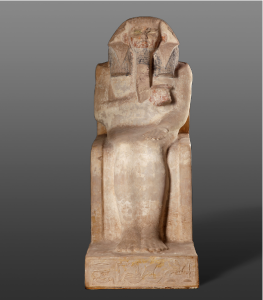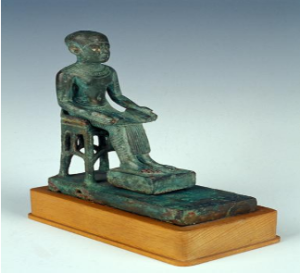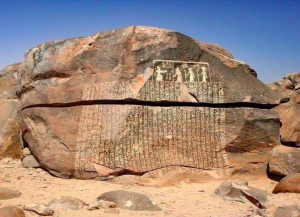DAS ALTE KÖNIGREICH: DIE HERRSCHAFT VON KÖNIG ZOSER
König Zoser, dessen Name "Körper des Gottes" bedeutet, regierte von 2630 bis 2601 v. Chr., also etwa 29 Jahre lang. Zu Beginn seiner Herrschaft gründete er eine neue Hauptstadt, Memphis, in der Nähe von Saqqara, und nannte seine Hauptstadt "Anbu Heg", was "die weiße Mauer" bedeutet. Die Ägypter nannten sie "Ra" (was "hoher Palast" bedeutet), weil er in einem großen Palast residierte. Während der Regierungszeit von König Zoser entwarf ein brillanter Architekt namens Imhotep, dessen Name "der in Frieden kam" bedeutet, eine revolutionäre Pyramide für den König. Diese um 2620 v. Chr. errichtete Pyramide bestand aus sechs gestuften Mastabas und ist als Stufenpyramide bekannt. Sie gilt als das erste groß angelegte Steinbauwerk der Welt und markiert einen bedeutenden Übergang von den früheren Mastaba-Gräbern zu den klassischen Pyramiden der späteren Pharaonen. Imhotep baute auch ein symbolisches Grab für Zoser in der Nekropole von Saqqara. Im Inneren der Pyramide wurden eine mit Granit ausgekleidete Grabkammer und zwei mit Fayence-Gefäßen geschmückte Kammern entdeckt, die von der fortschrittlichen Handwerkskunst der alten Ägypter zeugen.
König Zosers Errungenschaften
einschließlich: -Er führte Verfassungsänderungen ein, die die Befugnisse des Pharaos definierten und die Übertragung von Befugnissen an den Hohepriester (wie heute den Premierminister) ermöglichten. Außerdem legte er eine 30-jährige Regierungszeit fest und führte ein Fest (hub sed) ein, das gefeiert wurde. -Zoser schuf eine starke, gut organisierte Armee, um das Reich vor Nomadenstämmen zu schützen, und richtete in jeder Region eine dem Pharao direkt unterstellte Polizei ein. Außerdem führte er ein System von Getreidespeichern ein, um die Nahrungsmittelsicherheit zu gewährleisten.
Das Vermächtnis von König Zoser.
Das bedeutendste Vermächtnis von König Zoser ist die Stufenpyramide von Saqqara, ein Zeugnis des architektonischen Genies von Imhotep und ein wichtiger Meilenstein in der Entwicklung des Pyramidenbaus. Seine Regierungszeit markierte auch eine Periode bedeutender politischer und administrativer Reformen, die den Grundstein für das Alte Reich legten.
Die Statue von König Zoser
Die Statue von König Zoser, die in Saqqara entdeckt wurde. Sie ist eine der ältesten bekannten lebensgroßen Statuen und stellt den Pharao auf seinem Thron sitzend dar. Die Statue wurde 1924 in der unterirdischen Kammer der Stufenpyramide gefunden. Leider wurden die ursprünglichen Augen aus Kristall und Karneol gestohlen.

Imhotep: Der Meisterarchitekt
Imhotep, der Architekt und Minister von König Djoser, gilt als Pionier bei der Verwendung von Stein im Bauwesen, wie seine Arbeit an der Stufenpyramide in Saqqara beweist. Sein Name ist auf dem Sockel der Statue von König Djoser eingraviert, um seine Leistungen zu würdigen. Imhoteps außergewöhnliche Fähigkeiten zeigen sich auch in der Gestaltung und Konstruktion des gesamten Grabkomplexes von Saqqara. Obwohl sein Grab noch nicht entdeckt worden ist, weiß man, dass es sich im nördlichen Teil von Saqqara befindet. In späteren Epochen wuchs Imhoteps Ansehen so sehr, dass er vergöttert und als Gott der Heilung und Medizin verehrt wurde. Darstellungen von Imhotep zeigen ihn oft sitzend und in Ruhe eine Papyrusrolle lesend. Es wurden auch zahlreiche Bronzestatuen von ihm gefunden. Während der griechischen Periode setzten die Griechen Imhotep mit ihrem Gott der Medizin, Asklepios, gleich und bauten ihm zu Ehren weiterhin Tempel. Ein wichtiger Faktor für die Vergötterung Imhoteps ist die Geschichte, die auf dem Turiner Papyrus erzählt wird, der auch als Papyrus der Hungersnot bekannt ist. Dieser Papyrus aus der römischen Zeit beschreibt Ereignisse, die sich während der Herrschaft von König Djoser und Imhotep ereigneten. Dem Papyrus zufolge wurde Ägypten aufgrund eines niedrigen Nilhochwassers von einer schweren Hungersnot heimgesucht. In seiner Weisheit ordnete Imhotep den Bau von Getreidesilos an und verfügte, dass die Hälfte des geernteten Getreides in diesen Silos gelagert werden sollte, während die andere Hälfte an das Volk verteilt werden sollte. Dank Imhoteps Weitsicht konnten die Ägypter die Hungersnot überleben.








